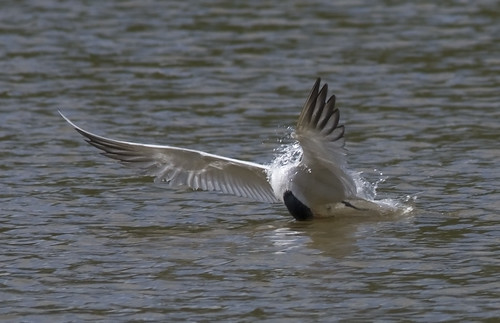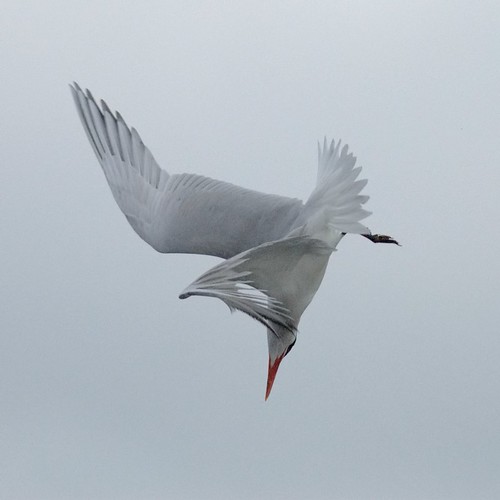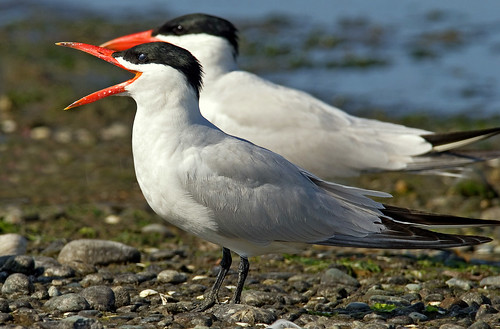In this moment I'd love to know what the tern is seeing. Are its eyes closed, covered by the nictitating membrane, or wide open making last nano-second modifications to snapping the prey. Earlier I was positing about the relative value of foot position going into and coming out of dives. Here it surely seems the tern has extended legs and is pushing off the water just as it prepares for a full flap down. Note there is no wing tip dimple on the water, but I'd be surprised if there weren't a couple in the second following. The wings, especially in the primaries, are flexed fully open to get the maximum lift away from the water.
Monday, August 31, 2009
Sunday, August 30, 2009
Caspian Tern playing with a crappie
Based on osprey1050's description it seems this Caspian Tern may have been playing with the fish. I would not be the least bit surprised if a second Caspian Tern in proximity that was this bird's youngster. Caspian Terns have a long period of parental care that anecdotally includes 'teaching' them to fish. August is the major month for post-breeding migrants to be moving south.
A wild turn in Finland
Turn tern puns are so easy to make, but this Caspian Tern in Finland is making a twist of the body that is nothing to laugh about. Knowing that these types of maneuvers are critical for successful plunge diving is always a concern when fitting harnesses on terns for telemetry.
Best feet forward?
The obvious amazing element of this photo is the bill has just cut the water without a ripple yet to break. The gape is open ready to grasp some hapless fish or perhaps it will be all splash and no lunch. Less conspicuous is the posture of the feet. As well as I know Caspian Terns I realize I don't know why the feet are forward in lieu of back. It would seem more stream lined to have them far back like the Pelicaniformes in their underwater pursuit for fish. Perhaps the feet forward are in position to allow for a quick burst off of the water. Caspians are not ones to sit and float on the water like a gull or even some of the smaller terns.
Wednesday, August 26, 2009
The last thing the fish saw was a big red bill
This photo has consistently ranked as one of the most interesting on Flickr and was the image I had in my mind when I read the wonderful species profile about Caspian Terns in the Sept/Oct BirdWatcher's Digest. Jim McCormac wrote a great article with some wonderful metaphors and comparisons that I found to be original and compelling. He was very gracious in mentioning this blog and the work I do with undergraduates at Willamette University. Birds have a special attraction that brings people together in a novel way. It was a world class turn of events to get to share some insights with the Bird Watcher's Digest readership. Any and all are encouraged to correspond with me directly about this great bird.
Friday, August 7, 2009
Dinner time in the Great Lakes
This photo shows a Caspian Tern colony in what is in many ways the most important week of the annual cycle and this year is a good one at Lake Ontario's Hamilton Harbour. The inference of great year is the large number of nearly fledged or recently fledged chicks. The chicks are every bird in the photo with speckling or chevrons marking the back of the wings (or mantle). Also you can see these same younger birds have orange bills instead of the intense red of the adults.
The fish coming to its final fate is around 14-15 cm and appears to be a clupeid of some kind.
Caspian Tern Flexible Billing
This photos shows the small amount of flexibility that is characteristic of many birds, especially the Charadriformes. The flexibility is due to a thinness at the base of the maxilla suture and probably adds to the capacity to hold and manipulate prey. This flexibility is also in part due to the quadrate bone at the base of the jaw. These characters together are among those that separate birds from their raptor-like relatives in the Dinosauria.








